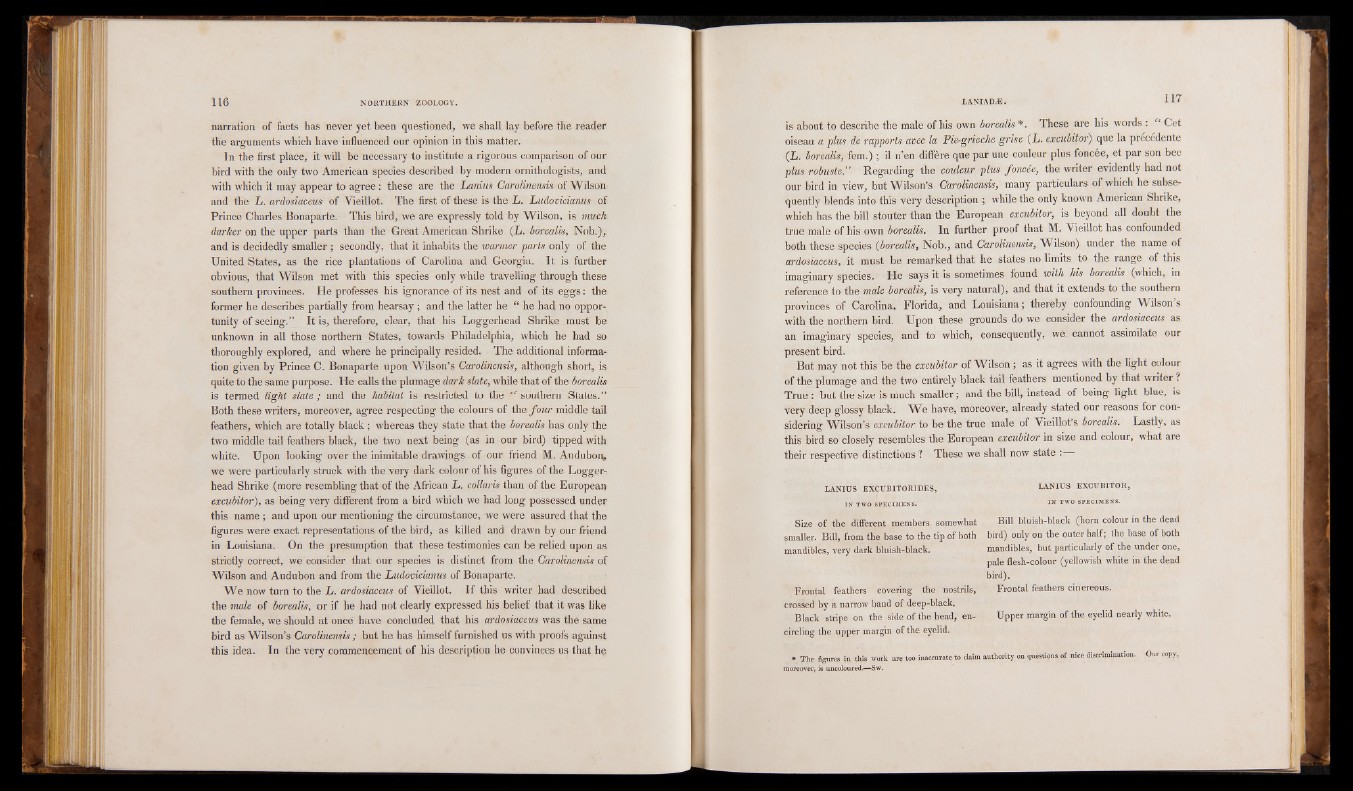
narration of facts has never yet been questioned, we shall lay before the reader
the arguments which have influenced our opinion in this matter.
In the first place, it will be necessary to institute a rigorous comparison of our
bird with the only two American species described by modern ornithologists, and
with which it may appear to agree: these are the Lanius Carolinensis of Wilson
and the L . ardosiaceus of Yieillot. The first of these is the L . Ludovicianus of
Prince Charles Bonaparte. This bird, we are expressly told by Wilson, is much
darker on the upper parts than the Great American Shrike (L. borealis, Nob.),
and is decidedly smaller ; secondly, that it inhabits the warmer parts only of the
United States, as the rice plantations of Carolina and Georgia. It is further
obvious, that Wilson met with this species only while travelling through these
southern provinces. He professes his ignorance of its nest and of its eggs: the
former he describes partially from hearsay ; and the latter he “ he had no opportunity
of seeing.” It is, therefore, clear, that his Loggerhead Shrike ,must be
unknown in all those northern States, towards Philadelphia, which he had so
thoroughly explored, and where he principally resided. The additional information
given by Prince C. Bonaparte upon Wilson’s Carolinensis, although short, is
quite to the same purpose. He calls the plumage dark slate, while that of the borealis is termed light slate ; and the habitat is restricted to the “ southern States.”
Both these writers, moreover, agree respecting the colours of the fo u r middle tail
feathers, which are totally black ; whereas they state that the borealis has only the
two middle tail feathers black, the two next being (as in our bird) tipped with
white. Upon looking over the inimitable drawings of our friend M. Audubon,
we were particularly struck with the very dark colour of his figures of the Logger-
head Shrike (more resembling that of the African L. collaris than of the European
excubitor), as being very different from a bird which we had long possessed under
this name ; and upon our mentioning the circumstance, we were assured that the
figures were exact representations of the bird, as killed and drawn by our friend
in Louisiana. On the presumption that these testimonies can be relied upon as
strictly correct, we consider that our species is distinct from the Carolinensis of
Wilson and Audubon and from the Ldidomcianus of Bonaparte.
We now turn to the L . ardosiaceus of Vieillot. If this writer had described
the male of borealis, or if he had not clearly expressed his belief that it was like
the female, we should at once have concluded that his ardosiaceus was the same
bird as Wilson’s Carolinensis ; but he has himself furnished us with proofs against
this idea. In the very commencement of his description he convinces us that he
is about to describe the male of his own borealis*. These are his words : “ Cet
oiseau a plus de rapports avec la Pie-grieche grise (L. excubitor) que la precedente
(L. borealis, fem.) ; il n’en diffère que par une couleur plus foncée, et par son bec
plus robuste.’’ Regarding the couleur plus foncée, the writer evidently had not
our bird in view, but Wilson’s Carolinensis, many particulars of which he subsequently
blends into this very description ; while the only known American Shrike,
which has the bill stouter than the European excubitor, is beyond all doubt the
true male of his own borealis. In further proof that M. Vieillot has confounded
both these species (borealis, Nob., and Carolinensis, "Wilson) under the name of
ardosiaceus,. it must be remarked that he states no limits to the range of this
imaginary species. He says it is sometimes found with his borealis (which, in
reference to the male borealis, is very natural), and that it extends to the southern
provinces of Carolina, Florida, and Louisiana; thereby confounding Wilson’s
with the northern bird. Upon these grounds do we consider the ardosiaceus as
an imaginary species, and to which, consequently, we. cannot assimilate our
preBsuent tm bairyd n.ot this be the excubitor of Wilson ; as it agrees with the light colour
of the plumage and the two entirely black tail feathers mentioned by that writer ?
True : but the size is much smaller; and the bill, instead of being light blue, is
very deep glossy black. We have, moreover, already stated our reasons for considering
Wilson’s excubitor to be the true male of Vieillots borealis. Lastly, as
this bird so closely resembles the European excubitor in size and colour, what are
their respective distinctions ? These we shall now state :
LANIUS EXCUB ITORIDES, LANIUS EXCUBITOR,
IK TWO SP EC IM E N S. « TWO SPEC IM EN S.
Size of the different members somewhat Bill bluish-black (horn colour in the dead
smaller. Bill, from the base to the tip of both bird) only on the outer half; the base of both
mandibles, very dark bluish-black. mandibles, but particularly of the under one,
pale flesh-colout (yellowish white in the dead
bird).
Frontal feathers covering the nostrils, Frontal feathers cinereous,
crossed by a narrow band of deep-black.
Black stripe on the side of the head, en- Upper margin of the eyelid nearly white,
circling the upper margin of the eyelid.
* The figures in this work are too
moreover, is uncoloured.—Sw.
inaccurate to claim authority on questions of nice discrimination. Our copy,